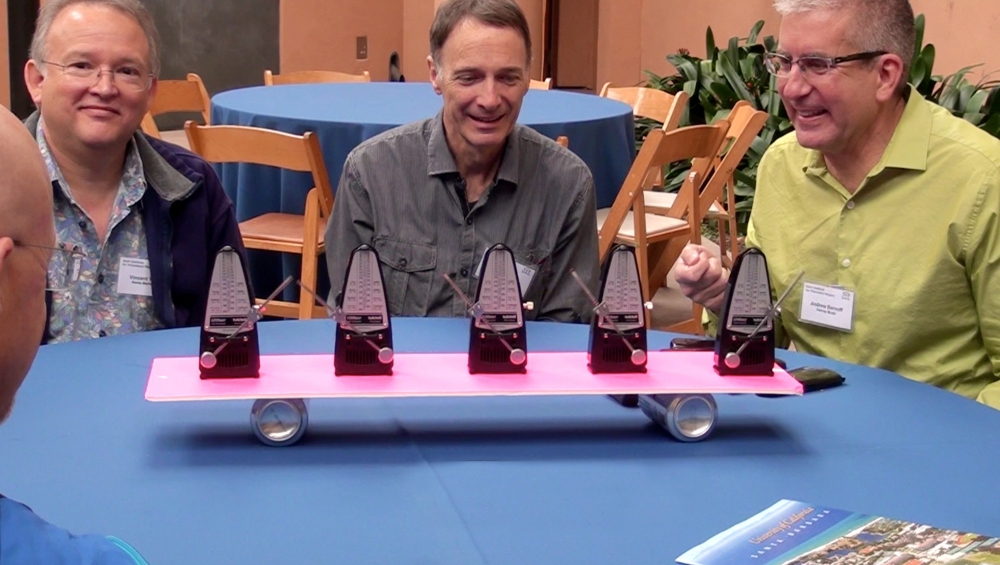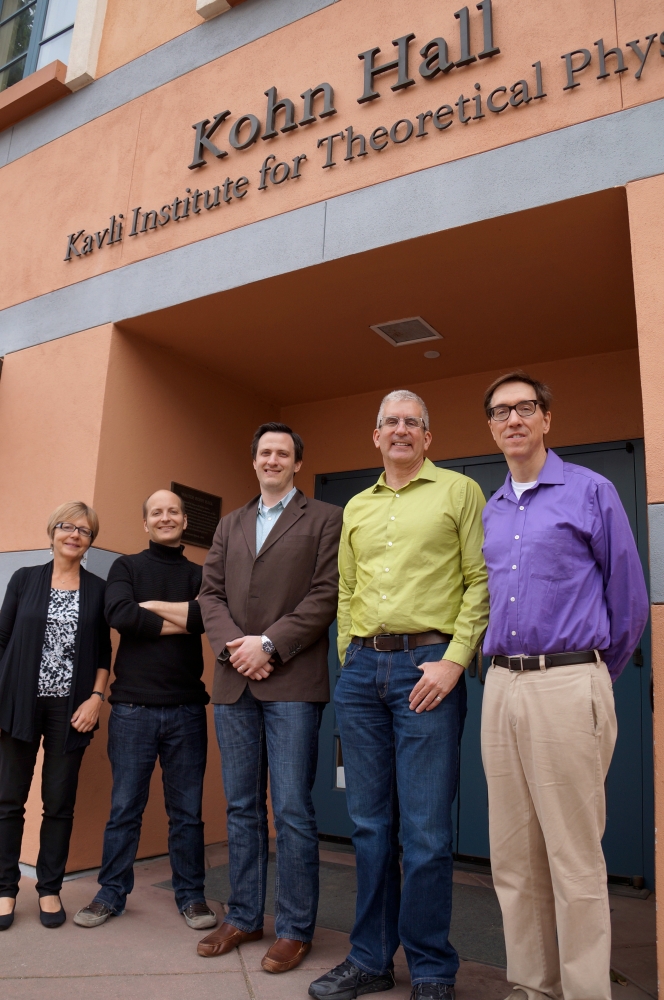Birds Do It. Bees Do It.


Birds flock. Bees swarm. These are just two of the many remarkable examples of collective behavior found in nature. Both were explored at UC Santa Barbara’s Kavli Institute for Theoretical Physics (KITP) in “The Physics of Flocking: From Cells to Crowds,” a one-day workshop for high school science educators.
Dozens of teachers from near and far gathered on Saturday, Feb. 15 to do some flocking and swarming themselves.
“We want to expose physics or science teachers to physicists on the cutting edge of research because when you’re a high school teacher, your opportunities to talk to scientists and interact with them are fairly limited,” says Greg Huber, deputy director of KITP and a professor in the Department of Physics. “We want to give them an opportunity to learn from top physics researchers in an intense environment, and that’s what we provide in this one-day workshop.”
As part of Andrew Bernoff’s presentation on “The Synchronization and Swarming of Clock and Flocks,” for example, the Diana and Kenneth Jonsson Professor and chair of the Department of Mathematics at Harvey Mudd College had the audience break into two groups. Each group followed a set of simple instructions to model collective animal movement, with one group eventually emulating the milling pattern used by both fish and ants.
Bernoff, who recently co-authored an extensive primer on swarm equilibria, talked about the collective behavior of insects such as aphids and locusts. At lunch he created an impromptu demonstration of synchrony using five metronomes set atop a board resting on two empty soda cans. The motions of the soda cans and board allow the oscillators (metronomes) to influence each other, which slowly causes the metronomes to synchronize.
The daylong program introduced teachers to the rapidly developing field of active matter. Speakers used examples of dynamic organization at various scales — from the coordinated patterns of behavior of groups of animals to the complex hierarchical structures found inside cells. Most of the visiting presenters were participants in a weeklong KITP program, “Active Matter: Cytoskeleton, Cells, Tissues and Flocks.”
Physicists have been able to capture some of this behavior by modeling birds as tiny flying magnetic spins that align with their neighbors according to simple rules. Thanks to these successes, flocking has become a paradigm for the behavior of living and non-living systems where a large number of individually driven units exhibit coherent organization at larger scales.
Such systems include suspensions of swimming bacteria, layers of migrating cells, long biopolymers driven by proteins in the cell cytoskeleton and collections of synthetic microswimmers. Physicists, biologists and mathematicians are using statistical physics to model the complex behavior of these systems and to identify unifying principles.
Conference coordinator Cristina Marchetti, the William R. Kenan Professor of Physics at Syracuse University, talked about active matter. “Instead of thinking of atoms and molecules, think about units that are able to generate their own motion, such as bacteria,” she said. “If you have a very dense suspension of bacteria swimming in fluid, they can exhibit all kinds of collective behavior.
“When grown on semi-solid substrates, they form all kinds of intricate, beautiful patterns,” Marchetti explained. “When in a fluid, they swim around very rapidly in swirling patterns and look like a ‘turbulent’ liquid. Some bacteria eventually organize themselves into solid-like structures called biofilms. Instead of molecules, you have these self-motile units, which through interactions organize to look like phases of matter.”
Jeffrey Guasto, assistant professor of mechanical engineering at Tufts University, uses experimental methods, mainly microfluidics and high-speed imaging, to understand the dynamics of swimming microorganisms, such as bacteria and sperm cells. His talk, “The Acrobatics of Swimming Bacteria,” revealed how marine bacteria with single tails are able to change the direction of their movement by buckling the hook that attaches the tail to the body. He also showed how the shapes of waves that move along sperm tails allow those cells to turn while swimming.
“I teach middle school, so while it’s not as technical as high school, in 7th grade we do study things like fertilization,” says Julie Kluss, a science teacher at Santa Barbara Junior High. “So the idea of how the sperm navigate is something that I could use to go off on a little tangent now that I know more about it.”
Xavier Trepat, a group leader at the Institute for Bioengineering of Catalonia in Barcelona, Spain, talked about physical forces that drive cells. His work on the mechanical forces that control the organized migration of cells and tissues is beginning to inform scientists’ understanding of important biological functions, such as wound healing, morphogenesis and collective cell invasion in cancer.
“I have attended these conferences for five or six years now and I always think of them as a rejuvenating day,” says Staci Richard, chair of the science department at Laguna Blanca School in Santa Barbara. “It’s a way to re-ignite what it is about science that’s interesting and creative.”



